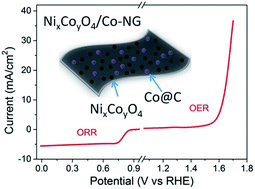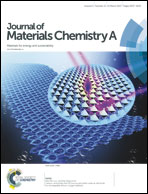Nickel–cobalt oxides supported on Co/N decorated graphene as an excellent bifunctional oxygen catalyst†
Abstract
The design of highly efficient electrocatalysts for the oxygen evolution reaction (OER) and oxygen reduction reaction (ORR) plays a key role in the development of various renewable energy storage and conversion devices. Recently, metal–organic framework (MOF) derived materials have shown great potential in ORR and OER; however, they may suffer from poor conductivity with limited electrochemical performance especially towards OER. In this work, nickel–cobalt oxides supported on Co/N decorated graphene were prepared by introducing nickel in a zeolitic imidazolate framework-67 (ZIF-67) as the precursor, which showed improved OER performance due to the as-derived NixCoyO4, and maintained the ORR performance of Co/N doped carbon at the same time. Meanwhile, graphene was utilized to further enhance the electrochemical surface area and charge transfer efficiency. The resulting composites show a potential of 0.796 V at 3 mA cm−2 and superior stability to Pt/C towards ORR, as well as a potential of 1.629 V to achieve 10 mA cm−2 current density for OER, which is much better than that of IrO2. In all, the overvoltage between ORR and OER was just 0.833 V, demonstrating the great potential of the composite in metal–air batteries as a bifunctional oxygen catalyst.



 Please wait while we load your content...
Please wait while we load your content...